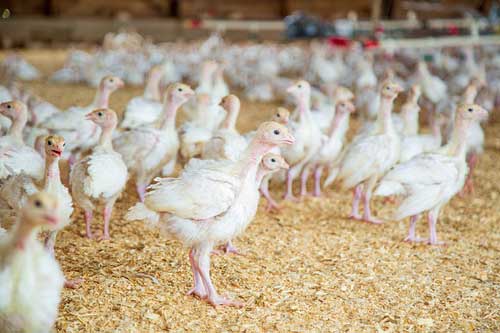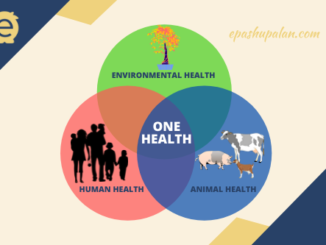The important news nowadays is avian influenza viral disease of wild and domestic birds. One of the most important economical disease of poultry industry. In India, four states birds are affected with this deadly disease. In common language avian influenza called as “Bird flu” or “Avian flu”. It is the highly contagious disease caused by the influenza virus including chicken, fowl, turkey, guinea fowl and other avian species which is adapted to the specific host. This has 3 types A, B and C. Influenza A virus is zoonotic, it is present as the natural reservoir in the birds because of this, we should know and awareness about Bird flu to humans as well as poultry industry. Avian influenza virus belongs to the family Orthomyxoviridae, genus Influenza. This virus is single standard RNA, negative sense and further categories as haemagglutinin (H1-16) and neuraminidase( N1-9) as subtypes. Avian influenza divided into two types. Bird flu virus H7 caused losses since 1800 with 100% mortality. Avian influenza strains are divided into two types based on their pathogenicity: high pathogenicity (HP) or low pathogenicity (LP).The most well-known HPAI strain, H5N1, appeared in China in 1996, and also has low pathogenic strains found in North America. Companion birds in captivity are unlikely to contract the virus and there has been no report of a companion bird with avian influenza since 2003. Pigeons do not contract or spread the virus.

Epidemiology: The disease is having worldwide prevalence , all age group birds are susceptible. Chicken and Turkey are highly susceptible. More outbreaks are observed in winter season. Migratory water fowl are the main reservoir of avian influenza virus. Chicken and Turkey are highly susceptible.
Route of transmission
The infected birds are the main source for spreading the infection. One bird is infected means whole flock infected and live bird marketing in rural areas. Faecal output and respiratory secretion are the source of the virus outbreak. If come into contact with dirt, cages, or any surfaces that have been contaminated by sick birds. If birds’ infected faeces and saliva get on farming equipment, like tractor wheels, clothing, & cages. By fomites such as wind, human, vehicle, poultry equipment, Feed and water, rodents and free range birds causing outbreak of the disease from infected area to the healthy area. Incubation period 1-5 days.
Pathogenesis
The virus present in the lower and upper respiratory tract. Replication occur in respiratory tract , digestive system and other systemic organs including brain.
Economic losses in poultry sector: Sudden death of birds and drastic fall in egg production and culling of birds leads severe economical losses. Due to outbreak news there will be drastic fall in demand for chicken and eggs leads to severe economical losses to farmers and breeders.
Clinical signs
Two types of Influenza virus based on pathogenicity:
Low pathogenicity avian influenza(LPAI)
High pathogenicity avian influenza (HPAI)
Based on the severity of virus, clinical signs shown to the birds
In Low pathogenicity avian influenza: The clinical signs as respiratory signs such as sneezing, ocular and nasal discharge, coughing, swollen infraorbital sinuses and sinusitis. In layers decreased in egg production and infertility, acute renal failure, visceral gout.
In high pathogenicity avian influenza: in this type the severity, systemic and high mortality occur. In this 100% mortality occurs. In per acute cases without clinical symptoms high death rate observed in the poultry. In acute cases, oedema, inappetance, dullness, depression, and cyanosis of head comb, wattles, oedema of face and Other Symptoms such as blood tinged oral and nasal discharge observed. Haemorrhagic lesions observed in featherless area such as shanks, feet and comb. Greenish diarrheal, torticollis, incoordination, opisthotinus, paralysis and drooped wings, and watery diarrhoea.
Clinical signs: Incubation period: 3-14 days, Birds found dead, fall in egg production, neurological signs, depression, anorexia, ruffled feathers, combs swollen, cyanotic, conjunctivitis and respiratory signs and sudden death.
Lesions
No lesions in suddenly died birds. Dehydration, congestion, oedema in head and neck, mucus exudates in trachea, haemorrhagic trachitis, congestion in kidney and haemorrhages in lymphoid tissues. Haemorrhages in sero mucosal layer, respiratory organs having inflammatory exudates, peritonitis, ruptured ovaries and follicles.
Diagnosis
- History of recent out breaks and sudden death of birds in the farm
- Sample collected from the swab of trachea, lung and air sacs.
- Virus isolation through inoculation in embryonated eggs.
- Based on clinical signs including sudden death, fall in egg production, facial oedema, cyanotic combs and wattles.
- Based on laboratory diagnostics : the cloacal and oropharyngeal swab should be taken for further confirmation of disease.
- Chicken embryo inoculation : allontoic route in 9-11 days old embryonated egg is used for the isolation of virus.
- Rt PCR used for early detection of viruses.
- Compliment fixation test.
- Allontoic fluid positive for heamagglutination to chicken erythrocytes.
- Serological tests- Double immunodiffusion test, ELISA, Hi tests.
Zoonotic importance
First human case reported in Hong Kong in 1997, 18 got infected and 6 got dies. In October 2005 WHO reports 117 confirmed cases of bird flu in human and out of 117 60 got died .Swine acts as mixing vessel in influenza infections. The main source of human transmission is handling of infected birds, contact of sick birds dropping and nasal secretions. Farm labours, managers, Veterinarian, butchers and poultry market vehicle staffs are at risk. Symptoms in humans are Typical flu like symptoms, Fever, Sore throat, Lethargy, Conjunctivitis (Eye Infection) ,Breathing problems, Chest pains Headache, Muscle aches, Cough, Pneumonia, Acute respiratory distress. Drugs such as amantadine and rimantadine used for the treatment of Influenza virus along with neuraminidase inhibitors such as oseltamivir, zanamivir used for the treatment.
Prevention
- Strict bio-security practices should be followed in the farm.
- Avoid the contact of wild birds, infected birds with healthy birds.
- Mixed age group and species of birds farming should be avoided.
- All in and all out farming policy should be practised in the farm.
- Hygienic practices in the farm.
- Avoid stress to birds.
Control
- Restrict the movement of human, vehicles and birds from one farm to another farm.
- Keep birds in enclosure so that they do not come into contact with wild birds.
- Regular vaccination and isolation of diseased birds with prompt treatment.
- Birds kept for exhibition or competition or sale should not be returned into farm.
- Application of Biosecurity.
- Awareness to the people, farmers and consumers about the disease spread and economical importance.
Reference
- msdvetmanual.com
- Avian influenza-OIE
- Control of Avian Influenza in Poultry by Ilaria Capua and Stefano Marangon






2 Trackbacks / Pingbacks